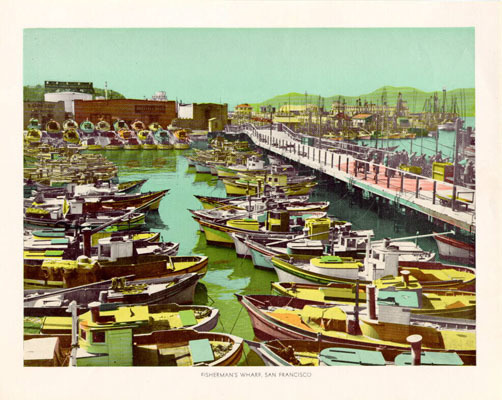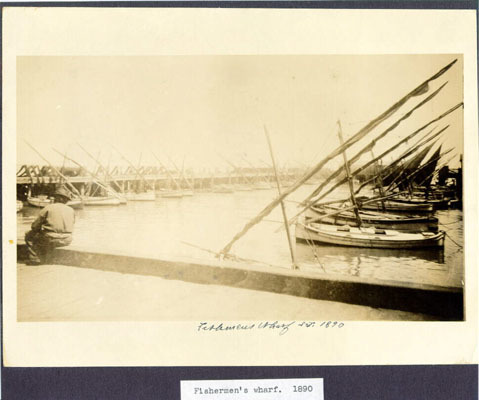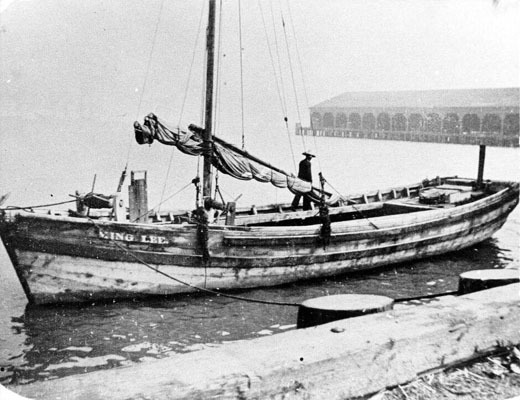Italian Entry into the Fishing Force
The Italian-American Experience at Fisherman’s Wharf
In this exhibit we intend to follow the lives of Italians who entered the fishing industry, especially at Fisherman’s Wharf. This exhibit will be organized loosely in chronological order. We will first examine why Italians became the predominant fishermen in San Francisco compared to other immigrants. Included in this part is an examination of methods that led to Italian Americans dominating the industry. After establishing Italians in the fishing force, the experiences and struggles of these fishermen and fisherwomen will be examined. This will include struggles during WWII and an exploration of what the children of fishers did.
Diversity objectives will be accomplished by examining the unique experiences and struggles of Italian fishers. Italian entry into the fishing industry and their later success will be explained as direct results of the “less white” categorization Italian immigrants held at the time. Their alienation will also be analyzed in respect to their World War II experiences.
This section intends to answer the question of “Why did so many Italians enter the fishing industry?”. Many Italian immigrants came in the 19th century in search of gold (Laurino 84), but why did they settle on fishing out of all the fields of work?
Italian immigrants often entered the fishing industry because it was marketed towards them as a part of the immigration experience. In his book From Italy to San Francisco: the immigrant experience, Dino Cinel, an Italian-American historian, writes that “Promotional literature claimed that Italians could profitably use their skills as farmers and fishermen in California, and several observers of the San Francisco Italian colony repeated the claim” (134). Fishing was advertised to Italians in the late 19th century, serving as a selling point for immigration. Those immigrating to San Francisco could be working the same job that they did in Italy, except they would be making more money and have a life with less hardship. Expanding this idea, being able to work the same job after immigrating is comforting since one doesn’t have to enter a new industry. Since immigration to San Francisco was marketed as an opportunity to fish and farm, it makes sense that those fields of work would be flooded with Italian immigrants. Along with attracting fishermen from Italy, immigrants unsure of what to do for work would’ve likely been pointed to fishing or farming. A point touched upon by Cinel is that Italians already had experience as fishers. This experience gave Italian fishers an upperhand in the industry which will be discussed in the Succes in the Fishing Industry section.
Approaching the question from a big picture perspective, it can be seen that a high Italian presence in the fishing industry is a result of Italian immigrant’s spot on the social ladder. Fishing hit the sweet spot in the working force for Italians. It was nowhere near the luxury of white collar jobs, but it wasn’t exactly at the bottom either. Cinel writes:
“Immigrants from other nations generally had better jobs than Italians. The reader should keep in mind that the Italians were the last major group to arrive in San Francisco, which may have put them at a disadvantage in the competition for jobs.”(137)
In the 19th century the West Coast was still a developing area and the social structure wasn’t as set in stone as the East Coast. However, as said by Cinel, Italians were the “last major group to arrive” and thus were left with the job opportunities not taken by other immigrants. This resonates with their spot as “less white” established in Thomas Guglielmo’s Are Italians White?. Italian immigrants were placed towards the bottom of the social ladder, but not below other races such as Asians, Latinos, and Africans. This explains why they were stuck with the unwanted jobs, but their place above other races can be seen by their displacement of Chinese fishers.
It’s important to point out that the Italian immigrants weren’t just given the fishing industry because nobody wanted it. They took it from the Chinese immigrants that were already living in California. Until the 1880’s, Chinese residents, who immigrated earlier than the Italians, dominated the fishing industry (Cinel 218). Cinel explains how Italians were able to take over the fishing force, “Superior ability was not the only reason for the success. Violence and intimidation also helped establish a quasi-monopoly, in a city where anti-Chinese sentiment made these tactics safe and useful ways to achieve economic success” (219). While Italians had the skills to dominate the fishing industry, it’s important to acknowledge that the level of their dominance was due to the racism present at the time. Society saw Italians as lower in the social ladder, but the Chinese were deemed even lower and thus the Italians were allowed to push them out of an industry that used to be Chinese dominated. This again reflects Italian resident’s place on the social ladder. They could only enter fishing because other white ethnicities didn’t want the industry, but since they were still categorized as white, nobody cared that they were displacing Chinese fishers.


